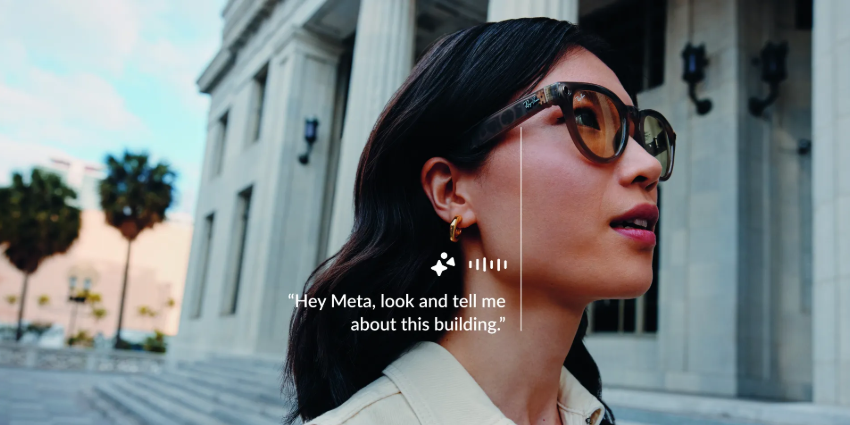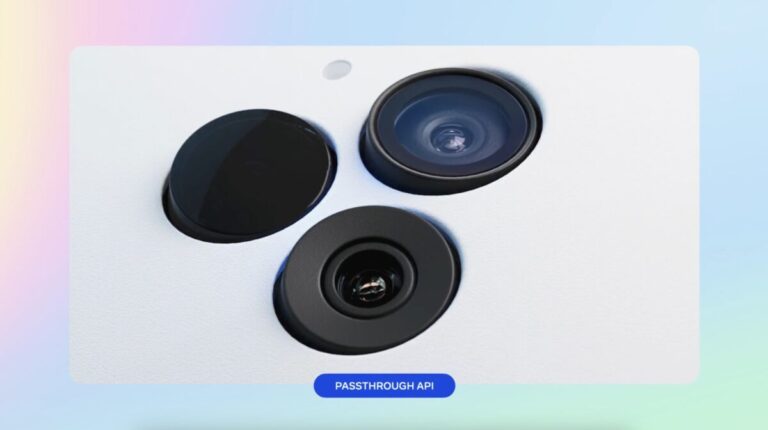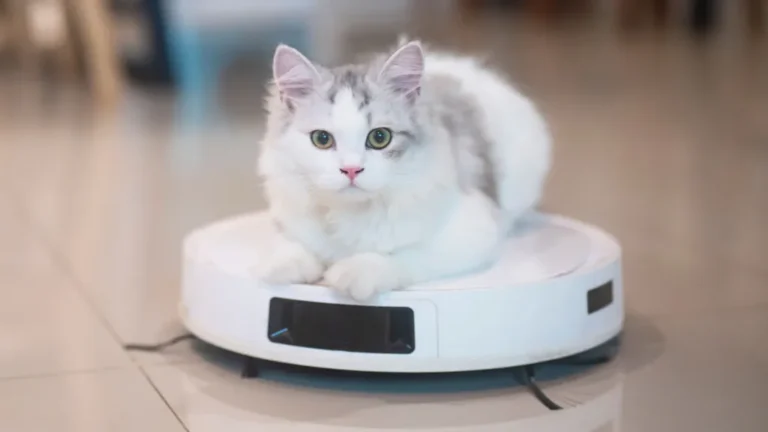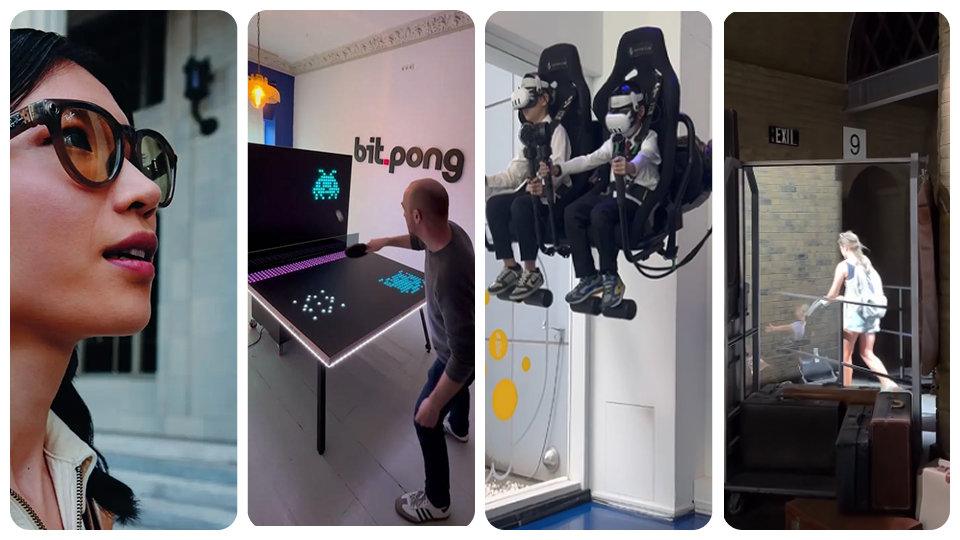April marked a noticeable move toward more embodied, hands-free, and responsive XR experiences. Wearables progressed rapidly with new capabilities from Meta, Google, and Apple. Meanwhile, gesture-based spaces, real-time AI, and adaptive visuals pointed to a future where interaction centres on environment, instinct, and personalisation rather than screens.
Here’s what stood out this month – and how it’s shaping the next phase of interactive design.
🕶️ SMART GLASSES, AI WEARABLES & PERSONAL AR
1 - Meta Ray-Ban Smart Glasses – Live Translation, Visual Search & AI Expansion
What’s new
Meta expanded its live translation and Meta AI features to more EU countries, bringing visual search, object identification, and spoken interaction directly into the user’s eyeline.
Why it matters
This approach establishes wearables as everyday tools – offering instant access to contextual information without needing a phone.
Where this is useful
- Navigation and wayfinding at events
- Guided activations or cultural tours
- Frontline roles needing language support
Our opinion
The market has finally moved from concept to practical implementation. These updates highlight where smart glasses truly excel – delivering subtle, useful guidance within immersive brand experiences. Our current prototypes focus on this precise combination of audio, glance, and gesture without screens. We’re seeing particularly strong results in cultural venue applications, where visitors engage with content while maintaining awareness of their surroundings.

2 - The AR Glasses Race – Meta vs Google vs Apple
What’s new
Google previewed its Gemini-powered glasses at TED 2025, with features like live translation and on-object information. Apple’s Project N50 continues to build momentum, while Meta’s Orion and Ray-Ban lines scale across more markets.
Why it matters
Three tech giants are now visibly committed to AR glasses. That’s meaningful – because it signals investment not just in hardware, but in the ecosystems needed to support them.
Where this is useful
- Self-guided tours and location-triggered content
- Smart factory overlays
- Retail navigation and inventory visibility
Our opinion
We’ve already shifted our R&D to develop activations without handheld devices. These updates confirm that direction. With AR wearables gaining momentum from multiple manufacturers, we predict this technology will transition from niche to standard in experience design within 12–18 months. Our most recent client workshops show increasing appetite for planning these implementations now rather than waiting for mass adoption.
Video Credit: Google @ TED2025
🧠 AI CHATBOTS WITH REAL-TIME WEB + FILE MEMORY
3 - GPT-4.1 Chatbots – Live Web + Brand-Trained Responses
What’s new
The latest OpenAI model blends live web search with internal file memory – allowing chatbots to combine public knowledge with custom brand training.
Why it matters
This creates responsive AI systems capable of answering questions with both live data and organisation-specific context.
Where this is useful
- Interactive product advisors at live events
- Voice-based installations
- Experiences that generate visuals, responses or narration on request
Our opinion
A recent project we delivered employed this approach – training a chatbot on internal content whilst pulling current information in real time. The result functioned as a dynamic interface rather than a simple tool. This technique allows experiences to adapt to guests spontaneously through conversation, voice, or generative visuals. We’re particularly impressed with how this reduces the knowledge maintenance burden for brands with rapidly evolving product lines.
🎟️ MULTI-SENSORY IMMERSION & SIMULATED MOTION
4 - Robotic Arm Motion Rides – Synchronized VR for Immersive Attractions
What’s new
New VR setups using industrial robotic arms are allowing real-time physical synchronisation with virtual environments. One notable demo this month showcased a high-speed dragon ride simulation with full-body G-force and motion feedback.
Why it matters
These systems combine precision movement, wind, visuals and sound – offering true multi-sensory immersion for audiences.
Where this is useful
- High-impact theme park activations
- Public showcases for sports, film or entertainment
- Location-based VR storytelling
Our opinion
Our design approach now incorporates movement as a narrative driver rather than merely visual content. This technology creates memorable physical moments, and we’re seeing brands invest in spatial design that balances cinematic quality with tangible sensation. The opportunities for branded entertainment in particular have expanded dramatically – we’ve already begun a pilot project using scaled-down versions for corporate events.
Video Credit – RoboEnter
🧱 INTERACTIVE SPACES & GESTURE TRACKING
5 - Gesture Walls & Spatial Games – Full-Body Interaction
What’s new
Recent activations have shown real-time tracking powering gamified walls and gesture-based painting – enabling guests to physically interact with visuals through movement and posture.
Why it matters
This form of body-led interaction removes the need for handsets or buttons – ideal for open, accessible, drop-in installations.
Where this is useful
- Fan parks and family-oriented brand zones
- Experiential education
- Public art and play spaces
Our opinion
These implementations demonstrate how intuitive, touch-free design has become essential for open public spaces. We’re applying similar configurations to create responsive playgrounds and brand touchpoints where engagement occurs naturally through motion. The removal of technical barriers has dramatically increased dwell time in our recent installations – visitors engage for 2-3 times longer when interactions feel physical rather than digital.
Video Credit: @roelofknol
Video Credit: Remi Bigot
6 - Platform 9¾ Illusions – Magic Through Simple Design
What’s new
Universal Orlando’s Platform 9¾ queue experience demonstrates how simple mirror illusions create convincing magic – guests appear to vanish through a brick wall just like in the Harry Potter films.
Why it matters
It’s proof that powerful storytelling doesn’t require expensive technology – just clever stagecraft, thoughtful design, and strategic misdirection.
Where this is useful
- Theme park queues and transitions
- Retail brand experiences
- Pop-up installations and traveling exhibits
- Budget-conscious immersive storytelling
Our opinion
We’re consistently inspired by these brilliantly efficient design solutions. Universal’s approach perfectly captures how theatrical techniques often outperform complex technology. With the right staging and psychological understanding, even the simplest mirror trick can create a moment of genuine wonder that guests remember and share. These low-tech but high-impact experiences are often more reliable, maintainable, and ultimately more magical than their high-tech counterparts.
Video Credit: @parkbenchtravel
Video Credit: Remi Bigot
6 - AI-Driven Visual Storytelling – Responsive, Trained Media
What’s new
Installations combining AI-generated content with live sensors, allowing projection visuals to shift based on audience interaction, emotion or movement.
Why it matters
These setups dynamically evolve with the audience, shaping stories based on interactions, emotions, and the situation.
Where this is useful
- Museums and interactive gallery spaces
- Art-led activations
- Responsive theatre or music visuals
- Branded corporate spaces – reception walls
Our opinion
We’re currently developing adaptive visual systems that convey narratives through rhythm, data and reaction. As brands seek more expressive formats, this technology provides a flexible canvas for style, narrative and atmosphere. Our recent museum collaborations show particular promise where content needs to remain fresh for returning visitors – the systems adapt and evolve rather than simply repeating the same experience.
Video Credit: Emil Lanne
🎓 IMMERSIVE TRAINING & XR SIMULATIONS
7 - Virtual Fire Drills & Safety Simulation in Headsets
What’s new
VR drills are now simulating high-pressure environments like warehouse fires or evacuations – complete with decision-making tasks, sensory prompts, and safety training metrics.
Why it matters
These experiences deliver repeatable, scalable training without real-world risk – especially valuable in compliance-heavy industries.
Where this is useful
- Logistics, shipping or aviation
- Factory training and onboarding
- Energy and defence environments
Our opinion
We’re witnessing steady demand for practical VR that delivers operational benefits. These applications serve as essential tools for reducing training costs, standardising processes, and improving knowledge retention across technical teams. Whilst the Quest & VisionPro headsets offer substantial entertainment value in gaming and fun activations, we consistently see value in these types of enterprise applications for our client needs.
Video Credit: Zac Duff
🧰 INDUSTRY COMMENTARY & TRENDS
8 - Meta Opens Up Mixed Reality API Access for Quest
What’s new
Meta has released developer access to Scene Understanding APIs for Quest 3 and 3S, providing developers with tools to better anchor and persist virtual content within physical spaces. This update enables applications to map rooms more effectively and remember object positions between sessions.
Why it matters
Persistent spatial anchoring has long been the missing element for creating truly embedded mixed reality experiences. This update addresses that fundamental limitation.
Our opinion
We’ve anticipated stable scene anchoring on Quest for some time – this finally unlocks spatial storytelling that remembers, persists and adapts. We’re already modifying an upcoming installation to incorporate these capabilities, particularly focusing on content that can react to and integrate with a visitor’s home environment rather than simply floating in space.

9 - Humane AI Pin – A Necessary Misstep?
What’s new
TechCrunch evaluated the Humane AI Pin – a wearable AI assistant that’s faced criticism for short battery life, inconsistent usability, and unclear purpose despite its innovative concept and significant investment.
Why it matters
The product highlights the challenges of creating truly useful wearable AI that goes beyond simply shrinking existing interfaces.
Our opinion
Wearable technology requires solving real problems in novel ways. Humane’s early challenges demonstrate that functionality and user experience must align perfectly. For brand applications, clarity of purpose remains paramount. While we admire the ambition, our installations emphasise focused utility over technological novelty – ensuring visitors immediately understand the value proposition.

10 - Meta Reality Labs Layoffs – Supernatural and XR Restructuring
What’s new
Meta has implemented significant staff reductions within Reality Labs, primarily affecting its fitness app Supernatural, whilst maintaining substantial investment in core VR/AR platform development. This represents a strategic refocusing rather than retreat from the XR market.
Why it matters
Even with strong financial backing, the XR industry is undergoing necessary consolidation around proven revenue models.
Our opinion
This restructuring reinforces our approach to designing flexible, cross-platform XR experiences that require minimal deployment resources – ensuring adaptability regardless of ecosystem evolution. We’re advising clients to focus on content that translates across multiple delivery methods rather than becoming overly dependent on specific hardware platforms or app environments. This modular approach ensures longer-term viability even as individual platforms shift.

11 - Smart Home Robotics – From Floor Cleaning to Cat Entertainmentg
What’s new
To wrap up, our insights with a fun one – British researchers at the University of Hertfordshire have proposed 100 innovative applications for domestic robot vacuums beyond floor cleaning – including pet entertainment, plant watering, reminder systems, and ambient environment control through programmable movement patterns.
Why it matters
The research demonstrates how existing technology can be repurposed through creative thinking rather than requiring new hardware development.
Our opinion
This research brilliantly captures effective experiential design principles: inventive, resourceful, and playful. Creative repurposing often support for better results than constant hardware iteration.

🔗 BBC News
This month’s XR and AI developments reveal a market evolving in three clear directions: wearables delivering practical everyday utility through voice, translation and navigation; experiential design transforming from static presentations to responsive, adaptive systems; and foundational improvements in technologies like GPT-4.1 and Quest APIs enabling capabilities that were previously impossible.
We’re creating experiences that genuinely respond to context, emotion, movement and inquiry – if that approach resonates with your vision, let’s collaborate.




